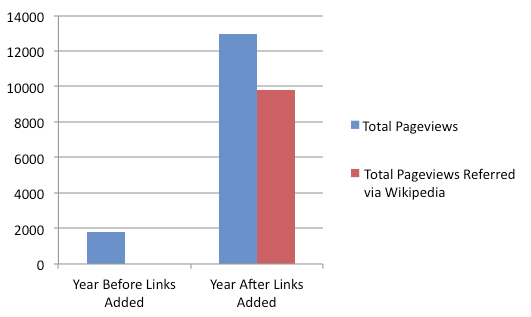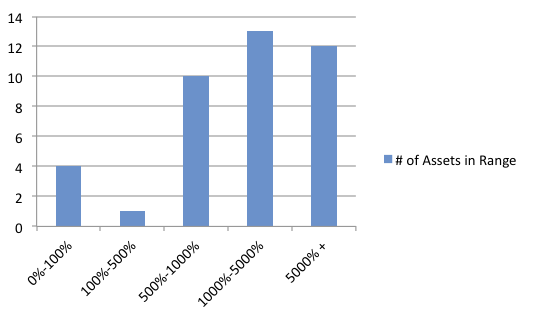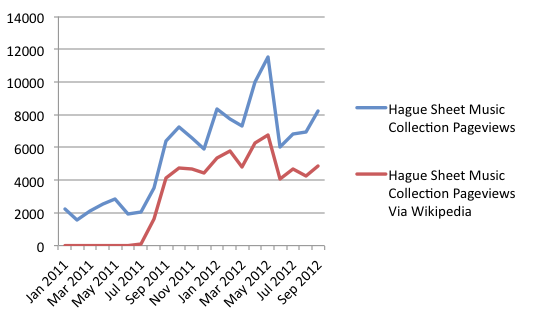Source:
http://www.dlib.org/dlib/march13/szajewski/03szajewski.html
D-Lib Magazine
Using Wikipedia to Enhance the Visibility of Digitized Archival Assets
Michael Szajewski
Ball State University
mgszajewski@bsu.edu
doi:10.1045/march2013-szajewski
Abstract
As an increasing number of archival repositories, libraries, and
cultural institutions build significant freely accessible digital
collections, archivists and digital librarians must continue to develop
digital outreach strategies that reflect the nature of searching and
discovery in today's information economy. This case study examines the
use of Wikipedia by the Ball State University Libraries as an
opportunity to raise the visibility of digitized historic sheet music
assets made available in the university's Digital Media Repository. By
adding links to specific items in this collection to relevant, existing
Wikipedia articles, Ball State successfully and efficiently expanded the
user base of this collection in the Digital Media Repository by vastly
enhancing the discoverability of the collection's assets.
Introduction
Beginning in 2010, Ball State University Archives and Special
Collections embarked on a program that aimed to increase the visibility
of digital archival assets in the
Ball State University Digital Media Repository
(DMR) by adding links to these assets to relevant articles on
Wikipedia. The DMR is a digital library developed by Ball State
University Libraries that provides "online access to a variety of
primary source materials, including photographs, oral history
interviews, artwork, video and film footage, cartographic resources,
architectural drawings, publications, and 3-dimensional objects." The
DMR includes materials digitized from the Ball State University Archives
and Special Collections, including materials documenting Muncie and
Delaware County history, Ball State history, and architecture in Indiana
(from Ball State University's Drawings and Documents Archive), as well
as other special collections, learning resources from other library
departments, and digital records from community organizations.
Wikipedia,
a ubiquitously popular resource that is collaboratively developed and
edited, provided the opportunity to directly link objects and
collections in the DMR to the Further reading, External links, and
Citations sections of articles.
This case study will discuss the use of Wikipedia to promote access
to and advance visibility of individual digitized archival assets
contained in the
Hague Sheet Music
collection, a digitized collection of 149 pieces of 19th and early-20th
century popular sheet music contained in the DMR (the materials were
collected by Frank Penwell and were donated to Ball State University
Libraries by Elizabeth Hague, his daughter, in 2006) and report the
impact of this initiative on the use of materials in this collection.
The case study will examine the opportunities for successful and
productive outreach conducted at the item level rather than solely the
collection level.
Background
As a growing number of archival repositories, libraries, and cultural
heritage institutions develop sizeable collections of freely available
digitized material similar to Ball State's DMR, there is a need for
archivists and digital librarians to re-imagine an approach to, and
methods for, increasing the visibility of digital assets. These types
of repositories and institutions have used Facebook, Twitter, blogs, and
other social networking outlets with frequency and success to promote
digital materials and services. A study published by Archivaria in 2010
authored by Adam Crymble demonstrated the breadth of the use of social
media as an outreach tool for archivists.
1
The Society of American Archivists has developed a webpage entitled
"The Interactive Archivist", a platform for the publication of case
studies and the sharing and compiling of web resources on the subject of
Web 2.0 and archival outreach, with pages devoted to the use of blogs
and social networking services.
2
While these initiatives should represent significant elements of a
digital outreach strategy, other efforts must be made to effectively
broaden the scope of online users reached by digital outreach programs.
How can a digital archival repository or library increase the
visibility of a resource on a global scale to users who would
potentially be interested in the resource but are unaware of its
existence and availability online? How do archivists and digital
librarians create paths leading to their digitally-available resources
that originate from relevant, high-traffic information-flow paths?
Issues related to global accessibility and discoverability addressed by
these questions are particularly relevant for digital archivists, since
these professionals frequently build collections that, due to the lack
of copyright restrictions, may be made freely accessible globally and
are not restricted to users at a particular institution. By critically
considering and addressing these questions, Ball State Archives and
Special Collections developed a program to use Wikipedia as an
opportunity to increase global visibility and reach
potentially-interested users.
Why Wikipedia?
Wikipedia was an obvious choice as a vehicle for increasing the
visibility of digitized archival materials because the resource is both
editable and tremendously popular. According to reports produced by
Alexa Internet Inc., an Internet information provider, Wikipedia.org is
the sixth-most visited website globally.
3
Beyond just general use, however, Wikipedia is widely used by students
during the research process. A study conducted by Alison J. Head and
Michael B. Eisenberg concluded that "[f]ar more students, than not, used
Wikipedia. Wikipedia was used in addition to a small set of other
commonly used information resources at the beginning of the research
process." The findings of this study demonstrate the potential of
Wikipedia to serve as a gateway to archival resources for students
beginning the research process.
4
The decision to explore the use of Wikipedia to increase the
visibility of archival resources was also influenced by published
scholarship on this topic. In 2008, Lauren Pressley and Carolyn J.
McCallum of Wake Forest University validated the usefulness of Wikipedia
for librarians, writing "they look for discovery tools that instantly
deliver information about desired topics in a user-friendly environment.
Wikipedia entries provide that instant information on numerous
topics." Supporting Wikipedia as a visibility-enhancing tool for
librarians, they wrote that "If librarians contribute to Wikipedia, it
might raise awareness of the library."
5
A more direct influence on the use of Wikipedia at Ball State was an
article published in 2007 by Ann M. Lally and Carolyn E. Dunford that
reports the authors' success in increasing visibility of University of
Washington digital collections by adding collection-level links to
relevant Wikipedia articles. Their analysis showed that, over a
one-year period, Wikipedia directed over 11,000 visitors to their
digital collections.
6
The Ball State University project and case study serves as an extension
of the work of Lally and Dunford that explores the adding of item-level
rather than collection-level links to Wikipedia.
Why the Hague Sheet Music Collection?
The Hague Sheet Music Collection presented itself as a natural
candidate for item-level linking from relevant Wikipedia articles after a
brief survey of Wikipedia revealed a high number of existing Wikipedia
articles for individual songs and songwriters that were documented in
this digital collection. Additionally, the nature of the collection's
content also made it an ideal candidate for this method of digital
outreach. While the items in the collection were grouped as such
because of a similar source (Elizabeth Hague) and format (sheet music),
they documented many different subjects (songs, songwriters, and
lyricists). A reasonable analysis of the collection would conclude that
Internet users could very likely be interested in one and only one
asset in the collection. Therefore, a digital outreach strategy that
provided this type of user with access and awareness to the relevant
individual assets in this digital collection at the item level, rather
than a strategy that markets the collection as a whole unit, was deemed
worthwhile.
Study
During an eight week period ranging from the end of July 2011 into
September 2011, 57 separate links to Hague Sheet Music Collection
digital assets in the DMR were added to relevant Wikipedia articles.
Decisions made regarding the addition of links to Wikipedia articles
were made on the basis of the existence of relevant articles; if a
Wikipedia article existed for a song, songwriter, or lyricist, a link to
the DMR asset was added. Links were typically placed in the "External
Links" section of the Wikipedia article. Regarding total links added, in
the month of July, 11 links were added; 32 links were added in the
month of August and 13 were added in September.
Regarding total assets linked, in the month of July, 9 individual
assets in the collection were linked to Wikipedia articles; 21 were
linked in August, and 10 were linked in September, adding up to a total
of 40 linked assets in this eight week period. The discrepancy between
these figures (40 and 57) exists because some assets were linked to
multiple Wikipedia articles, since Wikipedia articles existed for the
song, songwriter, and lyricist (or some combination of two of these
three) for some assets linked in this project. Twenty-seven assets were
linked once, 9 were linked twice, and 4 were linked three times.
Results
The impact of an asset being linked from Wikipedia on the asset's
total number of pageviews was significant. In total, the 40 assets that
were linked received 1,824 pageviews one year prior to being linked to
Wikipedia, with a pageview being defined as "an instance of a page being
loaded by a browser ... repeated views of a single page are also
counted."
7
One year after being linked, these same 40 assets were viewed a total
of 12,956 times, marking an increase in pageviews of 610.31%. Of these
12,956 pageviews that occurred one year following the addition of the
link or links, 9,824 were referred via Wikipedia. The number of
pageviews via Wikipedia during the one year period after these assets
were linked is 5.39 times greater than the total number of pageviews via
any source for these assets for the one year period prior to linking.
The figure below demonstrates the impact of the adding of links on the
traffic for these 40 assets.
Although the average percentage increase in pageviews for one asset
linked from Wikipedia in the Hague Sheet Music collection was 610.31%, a
wide range in increases was observed over the set of 40 assets linked.
Of the 40 assets linked, 12 exhibited pageview increases of over 5,000%
when compared the year prior to and the year following the addition of a
link or links. Thirteen linked assets exhibited pageview increases of
between 1,000% and 5,000%. One asset linked exhibited an increase
between 500% and 1,000%; ten exhibited increases between 100% and 500%;
four exhibited increases between 0% and 100%. The figure below depicts
this distribution of percentage increases in pageviews.
When analyzing whether assets that were linked multiple times
received a greater percentage increase in pageviews than assets that
were linked once, the data for this study actually showed that assets
that were linked once received a greater percentage increase when
comparing the year before and after linking (1,121.84%), than assets
that were linked twice (390.31%) or three times (515.16%). However,
this data was affected by the fact that two of the nine assets linked
twice, and one of the assets linked three times, received over 200
pageviews the year prior to being linked from Wikipedia, while only one
of the 27 assets linked once received 200 pageviews from Wikipedia
during this period, thus affecting the percentage of change. Further
research with a larger and more balanced sample size is necessary to
analyze the impact of the number of links added on the number of
pageviews received by the asset linked.
A few item-level examples can further demonstrate the vast impact of
using Wikipedia as a means of raising visibility for a digitized
archival item. On July 28, 2011, a link to the digitized version of the
sheet music for "It's a Long, Long Way To Tipperary", a popular song
from the 1910s,
8
from the digital Hague Sheet Music Collection was placed in the
External links section of an already-existing Wikipedia article for the
song. In the year prior to that date, the digital item had received 4
pageviews. In the year following that date, the digital item received
640 pageviews, an increase of 15,900%. Of these 640 pageviews, 582 were
referred via Wikipedia.
Other linked assets saw smaller but notable increases in use as a
result of Wikipedia linking. On August 10, 2011, a link to digitized
sheet music for the song "Margie", a 1920 song written by Con Conrad and
J. Russell Robinson
9,
was linked under the External links section for the Wikipedia article
on Con Conrad. During the year prior to this date, the asset received 1
pageview. In the following year, it received 44 pageviews, an increase
of 4,300%, with 31 of those pageviews being referred via Wikipedia.
Some assets that already received a significant number of pageviews
also received additional traffic as a result of linking from Wikipedia.
On August 26, 2011, links to digitized sheet music for "There's a Long,
Long Trail"
10
were added to Wikipedia articles for the song itself and for the
song's composer, Alonzo Elliott. During the year prior to linking, the
digitized item received 290 pageviews; 356 pageviews were recorded the
following year, an increase of 22.76%. Of those 356 pageviews, 102 were
referred via Wikipedia.
An analysis of the pageviews for the Hague Sheet Music Collection as a
whole (149 assets in total) also reveals that the addition of 57
Wikipedia links to 40 assets in the collection had a significant impact
on the total collection's pageviews. The chart below details the number
of collection pageviews for the Hague Sheet Music collection, the
number of these pageviews for which Wikipedia served as a referral
source, and the percentage of total collection pageviews referred via
Wikipedia. A collection pageview is defined as a pageview on an object
or set of objects in the collection as well as on the collection's
homepage.
| Month |
Hague Sheet Music Collection Pageviews |
Hague Sheet Music Collection Pageviews Via Wikipedia |
% of Pageviews Via Wikipedia |
| 11-Jan |
2265 |
1 |
0.04 |
| 11-Feb |
1553 |
0 |
0 |
| 11-Mar |
2125 |
0 |
0 |
| 11-Apr |
2549 |
0 |
0 |
| 11-May |
2870 |
2 |
0.07 |
| 11-Jun |
1955 |
0 |
0 |
| 11-Jul |
2049 |
100 |
4.88 |
| 11-Aug |
3527 |
1612 |
45.7 |
| 11-Sep |
6417 |
4123 |
64.25 |
| 11-Oct |
7254 |
4717 |
65.03 |
| 11-Nov |
6569 |
4680 |
71.24 |
| 11-Dec |
5932 |
4414 |
74.41 |
| 12-Jan |
8346 |
5324 |
63.79 |
| 12-Feb |
7763 |
5806 |
74.79 |
| 12-Mar |
7287 |
4788 |
65.71 |
| 12-Apr |
9999 |
6266 |
62.67 |
| 12-May |
11497 |
6769 |
58.88 |
| 12-Jun |
6048 |
4080 |
67.46 |
| 12-Jul |
6795 |
4699 |
69.15 |
| 12-Aug |
6934 |
4261 |
61.45 |
| 12-Sep |
8240 |
4953 |
60.11 |
As the data shows, the number of collection pageviews roughly tripled
in the period following the addition of the Wikipedia links, with
Wikipedia consistently providing between 50% and 75% of the traffic for
the total collection pageviews despite the fact that only 40 of the 149
assets were linked from Wikipedia.
Conclusion
The results of this study show that the addition of links from
relevant Wikipedia articles to individual digitized assets in the Hague
Sheet Music Collection in the Ball State University Digital Media
Repository was an overwhelming success. Despite the fact that only 57
links to 40 assets were added to Wikipedia articles, pageviews for the
collection of 149 assets roughly tripled as a result of this effort.
The adding of links at the item level provided a plethora of
highly-visible entry points to this collection's assets, raising
awareness of the existence of these resources to interested Internet
users who were previously unaware of these materials, as is suggested by
the collection's use statistics. The success of this initiative is
also remarkable in its efficiency, generating a large number of new
digital patrons while requiring relatively little time to plan and
execute.
Archivists organize records by collections. Therefore, archivists and
digital librarians may be susceptible to the tendency to think solely
at the collection level when promoting resources. However, the results
of this study show that an outreach strategy that limits
visibility-raising efforts solely to the collection level is limited in
its ability to reach numerous potential digital patrons. The use pattern
of digital patrons observed in this study shows that users of the
digitized Hague Sheet Music assets are often not just simply interested
in digitized sheet music, but rather are often interested in specific
songs and songwriters. Their discovery of assets in the Hague Sheet
Music collection via Wikipedia articles about specific songs,
songwriters, and lyricists supports this characterization. When
attempting to connect with potential digital patrons whose web searches
are conducted at this level of specificity, archivists can achieve
greater success in generating collection use by using Wikipedia to
connect users with digital archival materials at the item level.
Notes
1 Crymble, Adam. "
An Analysis of Twitter and Facebook Use by the Archival Community."
Archivaria. 70 (Fall 2010): 125.
2 The Interactive Archivist: Case Studies in Utilizing Web 2.0 to Improve the Archival Experience. Society of American Archivists.
3 "
Alexa Top 500 Global Sites."
Alexa.com. Alexa: The Web Information Company.
4 Head, Alison J. and Michael B. Eisenberg. "
How today's college students use Wikipedia for course-related research."
First Monday 15(3) (1 Mar 2010).
5 Pressley, Lauren and Carolyn J. McCallum. "
Putting the Library in Wikipedia."
Online 32(5) (Sep/Oct 2008).
6 Lally, Ann M. and Carolyn E. Dunford. "Using Wikipedia to Extend Digital Collections."
D-Lib Magazine 13(5/6) (May/June 2007).
http://dx.doi.org/10.1045/may2007-lally
7 "
Pageview - Analytics Help".
Google Analytics. Google.
8 Judge, Jack and Harry Williams. "
It's Long, Long Way to Tipperary." New York: Chappell & Co., Ltd. (1912).
9 Conrad, Con and J. Russel Robinson. "
Margie." New York: Waterson, Berlin & Snyder Co. (1920).
10 Elliott, Zo. "
There's a Long, Long Trail." New York: M. Witmark & Sons. (1914).
About the Author
 |
Michael Szajewski has served as Archivist for
Digital Development and University Records at Ball State University
since 2011. In this
position, he develops and promotes digital collections, manages
digitization projects, and oversees Ball State's university records
collection area. He earned a Bachelor of Arts degree in history and
communication studies from Northwestern University in 2009 and a Master
of Library Science degree from Indiana University in 2010 with a
concentration in archives and records management. |
Using Wikipedia to Enhance the Visibility of Digitized Archival Assets





